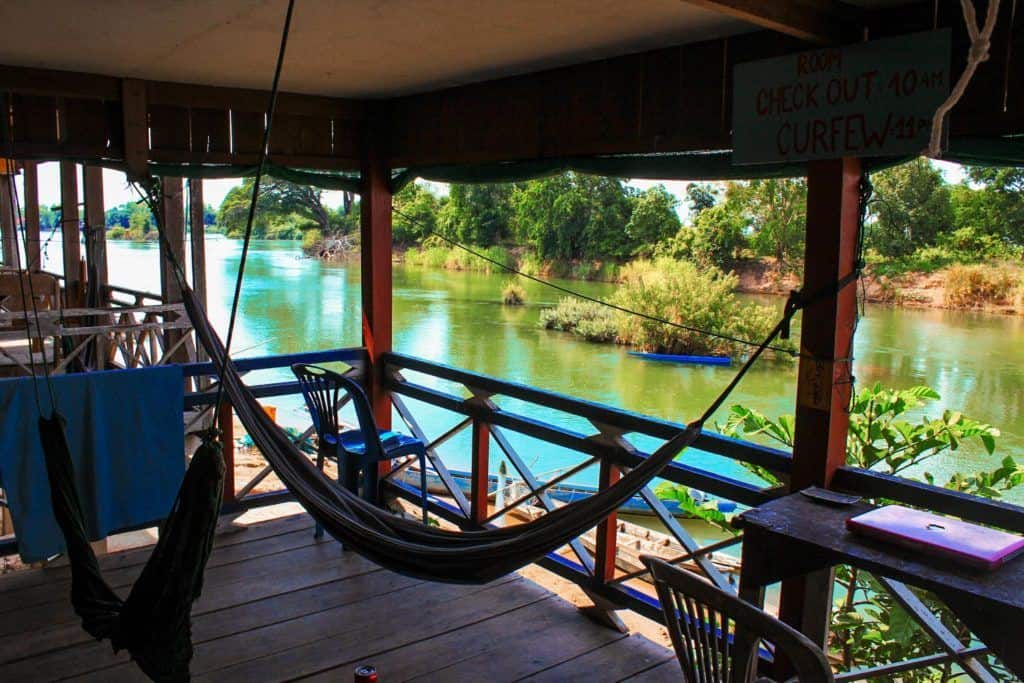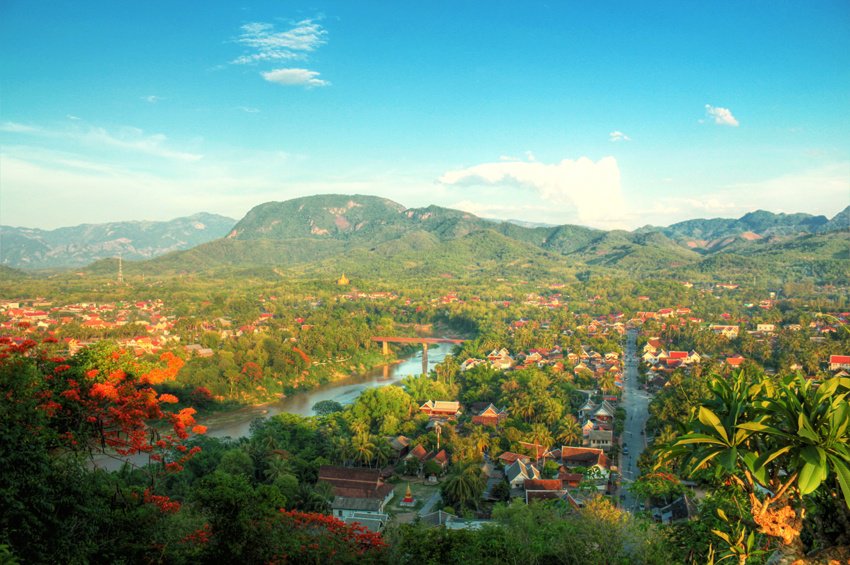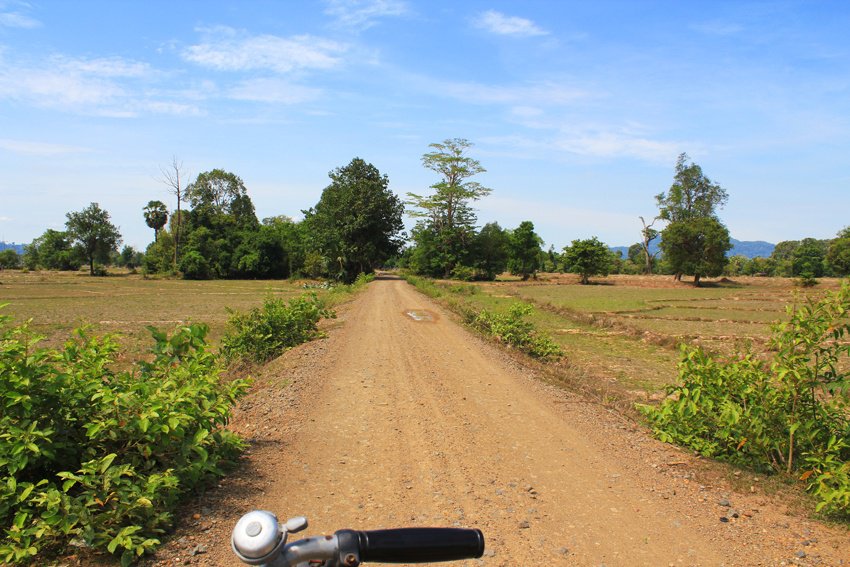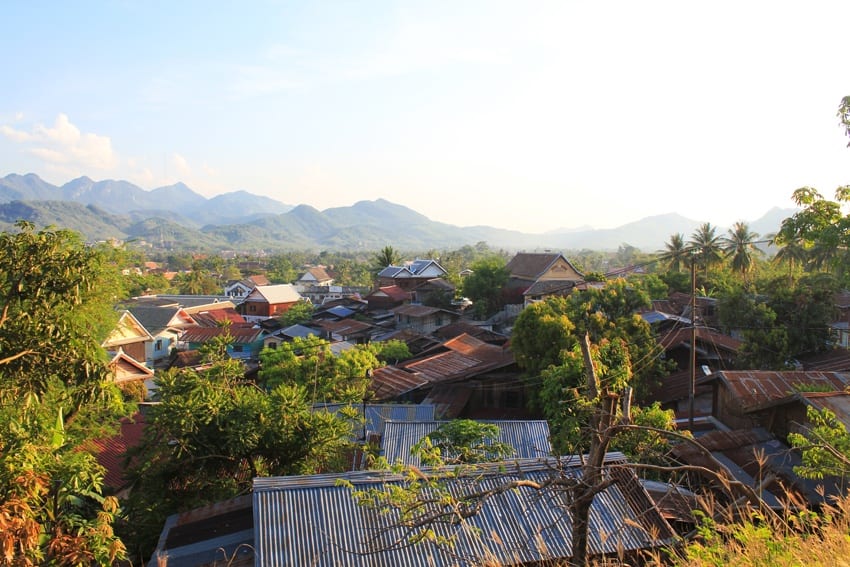Laos is such an underrated country.
Sure, it doesn’t have Thailand’s beaches or Cambodia’s Angkor Wat, or even Vietnam’s food scene, but what it does have is beautiful scenery, friendly locals, wonderful architecture, and a laidback vibe. And seriously — I highly recommend visiting. Too many travellers overlook Laos, and that’s a huge mistake.
And hey, it’s inexpensive, too. While Laos is perhaps marginally pricier than Thailand, Vietnam, and Cambodia, it’s nothing that’s going to break the bank. Even as prices for travel have risen around the world since the pandemic, this is one country that remains very affordable to visit.
If you’re wondering how much it costs to travel in Laos, this is the post for you. I’ve been tracking every single cent I’ve spent while travelling around the world since 2011 and today, I’m excited to share how much I spent on my trips to Laos.
Let’s get started.

What to Know About Money in Laos
Laos’ currency is called the Kip (LAK) and one U.S. dollar is typically worth, um, 20,800 kip. There’s no need to worry too much about the conversion, however, as U.S. dollars are widely accepted throughout the country, as well as Thai Baht. You won’t have to pay with kip too often.
Yes, most people use U.S. dollars in Laos, so don’t be surprised to see many prices quoted in USD, although both currencies are accepted everywhere. In convenience stores and markets, you’ll most likely be quoted in kip. The ATMs dispense kip and can be found almost everywhere.
You can’t take any kip outside of Laos, so make sure you exchange any before leaving the country or you’ll be stuck with them. This also means you won’t be able to exchange your money into kip before you arrive in the country. But no worries — U.S. dollars will be more useful in Laos anyway. All of the prices in this post are quoted in USD.

How to Find Cheap Flights to Laos
If you’ll be entering Laos from anywhere outside of Southeast and East Asia, you’ll be doing so via an indirect route. Yes, direct flights to Laos simply don’t exist from Europe, the Americas, Africa, or Oceania.
To find cheap flights from any of these regions, then, my first recommendation is Secret Flying and my second is Skyscanner.
Secret Flying is my number one flying trick and it’s rare for me to travel anywhere on a flight that wasn’t found through that website. It’s a flight deals site that shares some of the absolute best prices for airfare that’s recently gone on sale. It’s thanks to Secret Flying that I flew from Lisbon to Cape Town for €280 return, Rome to Japan for €350 return, London to Los Angeles for $120, and Singapore to London for $120. In short, regularly checking flights from your home country to Southeast Asia will help you save a lot of money.
First, check Secret Flying deals to Southeast Asia as a whole from the U.S., Canada, Australia, or wherever else you’re from. You’ll likely be able to pick up a flight to somewhere nearby — most likely Bangkok, Ho Chi Minh City, Kuala Lumpur, or Singapore — for as little as $350 return. From there, you can use Skyscanner to find flights to Laos.
Of course, if Secret Flying doesn’t have any great deals showing or you want to get to Laos with the least amount of hassle, you can use Skyscanner from the get-go. After 10 years of continuous travel, it’s my favourite way to search for flights. I love that you can look for flights from anywhere in an entire country to Laos, and that you can search for travel dates across a whole month to ensure you’re flying on the cheapest days.
As always, the more flexible your plans, the easier you’ll find it to save money on flights. If you’re happy to fly into and out of different airports, you may be able to pick up a deal (flying into Luang Prabang and out of Vientiane, for example), and if you’re happy to visit at any time of year, you’ll be able to pick and choose the best prices, too.

The Cost of Accommodation in Laos
Fun fact: the cheapest accommodation of my life was somewhere I stayed in Laos. I spent a whopping 75 U.S. cents a night to stay in a place that was… admittedly very, very grim. I absolutely wouldn’t recommend the experience, but it does show how cheap a bed for the night can be here!
When it comes to saving money on accommodation, let’s start with the options for budget travellers. If you’re backpacking through Southeast Asia on a tight budget, you’ll be impressed by how little money you can spend in this country.
The first option is hostels. Laos has hostels in all major tourist destinations, and they’re one of your best options for saving money while still making friends. I always recommend staying in hostels if you’re going to be travelling solo: I use Hostelworld to help me find the best prices and so I can check the reviews!
They’re similarly priced to elsewhere in Southeast Asia, so you can find somewhere to stay for not very much at all. You can expect to spend around $5-10 a night for a dorm bed in a decent hostel, and $20-30 for a private room. If you’re travelling with a friend or as part of a couple, you may find you end up spending a similar amount on a private room as for two beds in a dorm.
Housesitting is an option if you’re going to be trying to save as much money as possible but want to stay in nicer accommodation. The best option for Laos is Trusted Housesitters, and there are usually a couple of options up for grabs in the country — although not a huge amount. Housesitting allows you to stay in somebody’s house for free, usually while taking care of their pets, and is a fantastic way to spend more time in Laos without breaking the bank.
Finally, when it comes to free accommodation, also check out WorkAway. This is a volunteering-based organisation that lists places which will give you a free stay in exchange for all kinds of work (think: teaching English, volunteering at a butterfly park, or helping to run an off-the-grid jungle farm).

Okay, but what if you’re not a budget traveller and just want to stay in a lovely, well-reviewed hotel or guesthouse that’s good value for money and has all the things you need from a place to lay your head? I’ve got you! I’ve visited Laos on all kinds of budgets, and was blown away by how much I could get for my money. For under $50 a night, you’ll be able to stay in a seriously impressive hotel.
Fan rooms are always cheaper than air conditioned rooms, so if you’re looking to save a little money and it isn’t too hot while you’re in town, go for the fan option — it’ll be about 40% less.
A note that you should ignore any accommodation-based touts. If somebody greets you off the bus or boat and tries to convince you to check out their guesthouse, don’t do it! I made this mistake in Luang Prabang and ended up staying in a place that was ranking 1298 out of 1350[!] on TripAdvisor.
After my most recent trip, here are a few of my favourite places to stay in Laos:
Luang Prabang: Sadakham Hotel ($45 per night)
The beautiful Old Town of Luang Prabang is by far the most popular place to visit in Laos, which can make hotels there quite expensive. That’s why I was so happy to find Sadakham Hotel, which was nicer than any of the other places I’ve stayed in this area, but still very reasonably priced. It’s a really peaceful spot despite being so close to the bustling old town, and my room was very clean, spacious, and modern. Breakfast was delicious (and huge!), and the staff were always friendly and happy to give restaurant recommendations or help me arrange day trips. I used the free bikes they offered to explore all around the city, and loved being so close to Mount Phou Si: I headed up there every evening for those epic sunset views!
4000 Islands: Dokchampa Guesthouse ($20 per night)
I’ve stayed in a lot of sleepy riverside places during my years in Southeast Asia, but I think Don Khon in the 4000 Islands is probably the most laid back of them all. The larger and quieter of the two main islands that tourists go to, I planned to stay for two nights on my first visit, and ended up staying for a week! Dokchampa Guesthouse was the ideal spot to relax and do a whole lot of not much for a few days: the hammocks on the balcony were the perfect spot to lie and watch the sun go down each evening with an ice-cold bottle of Beer Lao in hand. My room was huge and unusually nice for this part of Laos, and the air-con was definitely worth the extra money when it came time to sleep! There are a few good restaurants nearby, but I ended up eating at the guesthouse most nights: the local Laotian dishes that came out of the kitchen there were as good as any I had anywhere!
Vang Vieng: Vang Vieng Camellia Hotel ($26 per night)
Once an infamous backpacker hangout, Vang Vieng is now a much more chilled place for adventure sports or just enjoying the beautiful surroundings. I’ve stayed in a couple of different places here, and prefer Camellia Hotel: it’s an affordable hotel that’s right in the heart of things but on a quiet back street so there wasn’t any road noise. My room had great views of the mountains that surround the town, and was clean and more than big enough for two people. Breakfast was a simple but tasty affair, and there are a whole bunch of good restaurants within a few minutes’ walk. The hard-working staff were lovely and helpful, and we were able to rent a scooter from them to explore all around the area at a very reasonable price. I’d stay there again in a heartbeat.

The Cost of Transportation in Laos
Laos a small country, but getting around can be a pain the ass. Literally, if you’re planning to do so by minivan. And it can be time-consuming as hell if you decide to opt for the accurately-named slow boats.
If you’re on a tight budget, overland travel is always going to be least expensive, so I recommend travelling by bus or minivan, train, or boat, depending on where you’re heading. China has invested heavily in infrastructure projects in Laos recently, which if nothing else has meant the quality of the roads between some of the major centres has improved a lot in recent years.
The opening of the new railway in 2021 has also made a huge difference to how fast and comfortable it is to get around the north of the country. There are ten passenger stations, and if you’re travelling anywhere between Vientiane, Vang Vieng, and Luang Prabang, this is the best way to do it.
As an example, it now takes barely an hour to get between Vientiane and Vang Vieng on the high-speed train, versus 3-5 hours on the bus. Likewise, it’s around two hours between Vientiane and Luang Prabang, instead of a gruelling all-day journey on a bus or minivan.
If you’re heading down to Pakse and the 4000 Islands, though, or somewhere else away from the rail route, you’ll be using buses, minivans, or taxis. The condition of both the roads and the vehicles varies a lot: better on the main routes, worse (sometimes, much worse) in remote areas.
The easiest way to book both trains and buses online is with 12Go Asia, which is who I use for all my transport bookings in this part of the world.
If you have a little more cash to splash and want to cut down on some of those long, tiring travel days, you can opt to fly between destinations. I took a flight between Luang Prabang and Pakse to skip a 22-hour bus ride and it was more than worth the $60 I spent. It was under two hours by plane!
I wouldn’t recommend hiring a car in Laos. The roads are bad and dangerous, it’s tricky to get your hands on a Laotian driving license, and so it simply isn’t worth the effort and hassle it’ll take to get it all set up. Take the bus instead, or fly if you’re short on time.
You’ll find most towns and cities extremely walkable, so you can save on local transportation costs by travelling with your own two feet. Tuk-tuks are known as jumbos in Laos, and are a good option if you’re heading somewhere that’s too far to walk — expect to pay a few dollars for these. And negotiate! Always negotiate down to around 50% of the initial price, and if in doubt, walk away. If you’ve gone too low, the driver will just let you leave.
Here are several example prices from my most recent trips; they’re all correct as of March 2024.
- Vientiane to Pakse: Overnight bus – $21
- Vientiane to Luang Prabang: Train – $29, bus/minivan – $16
- Luang Prabang to Vang Vieng: Train – $18, bus – $18
- Pakse to 4000 Islands: Bus + boat – $11
- Luang Prabang to Huay Xai: Slow boat (two days with overnight in Pak Beng) – $30
- Pakse to Savannakhet: Minivan – $15

The Cost of Food in Laos
Laotian food is often overlooked by travellers in Southeast Asia; mistakenly viewed as being bland and boring in comparison to fiery Thai dishes and complex Vietnamese soups. Don’t buy into the rumours: there’s plenty of delicious dishes to sink your teeth into in Laos. Also, baguettes!!!! The bread in Laos is some of the best I’ve ever had.
When in doubt, hit the streets for a tasty inexpensive treat. Street food is nearly always delicious and costs just a dollar or two. It makes saving money on food incredibly easy. If in doubt, look to the locals. They aren’t going to eat at places that will make them sick, so if you see a popular spot with a line of hungry people, that’s a good sign you should grab some of whatever they’re eating.
And as for restaurants, they’re everywhere and reasonably affordable compared to the street food goodness. A two-course meal with a beer will come to around $10.
Speaking of beer, you can usually grab a can for around $1 — less if you’re buying it from a convenience store — so drinking is fairly cheap.
Laos’ tap water is unfortunately not safe to drink, so you’ll want to either buy bottled water or use a Steripen to safely purify the tap water and cut down on plastic. night market buffet luang prabang all can eat
In Laos, I don’t recommend cooking your own food unless you have a strict dietary requirement. Buying ingredients for meals is simply too expensive — you can easily spend $10 or more on ingredients for a dish that you can get for $1 on the streets, and most accommodation doesn’t have cooking facilities anyway.
In general, I’d recommend expecting to spend around $7 a day if you’re on a tight backpacker budget eating exclusively street food, $15 a day if you’ll be occasionally eating in restaurants, and $50 a day if you plan on eating at higher-end places three times a day.

The Cost of Activities in Laos
There’s so much to keep you entertained in Laos, and even better, many of the activities are free or very cheap. In fact, I spent hardly any money on activities and entrance fees in Laos because there was so much to do that didn’t cost a Kip!
You’ll almost certainly be spending some time in Luang Prabang: it’s a popular place to visit, and one of my favourite spots in the country! There’s lots to keep you busy while you’re in town.
The temples in Luang Prabang are seriously beautiful, dwarfed only by the French colonial architecture in the Old Quarter. Expect to spend several hours just wandering through town, soaking up the vibe and taking dozens of photos.
Set your alarm for 5 a.m. one morning so that you can witness the magical morning alms-giving ceremony. Be wary of any locals that approach you during the ceremony and try to get you to participate, however — this is a scam! A, um, scam that I fell for.
When the sun starts to set, head up to the temple at the top of Mount Phousi for the best view in town! It’s not a difficult walk unless it’s an especially hot day, with steps the whole way: you can walk up from either side. There’s a small 20,000 LAK ($1) entry fee at the top.
You definitely won’t want to miss Kuang Si Falls either, which are pictured at the top of this section and are absolutely stunning. You’ll pay 25,000 LAK ($1.20 USD) to enter, and a few dollars for the tuk-tuk there and back, but it’s more than worth the money. My advice is to get there early, though, as the falls do get pretty busy from late morning onward.
Elsewhere in the country, you’ll want to head to the ridiculously chilled-out 4,000 Islands in the south. Here, your main activity will predominantly be lazing in a hammock and watching the Mekong drift by while wondering whether you can extend your stay another week. Before you head to the islands, I highly recommend a few days in the Boloven Plateau, which you can reach from Pakse. It’s a remarkably relaxed part of the country, less-visited by tourists, and well worth exploring — especially on two wheels.
Something I love to do when I travel is take tours! I always book mine through GetYourGuide or Viator, no matter where I am in the world. Here’s an idea of the costs you can expect to be up for with these tours:
- Luang Prabang market tour with private cooking class: $92
- Guided mountain bike tour in the Luang Prabang countryside: $39
- Boloven Plateau full-day waterfall hike from Pakse: $155
- Two-Day Vang Vieng tour from Vientiane: $329

Miscellaneous Expenses for Laos
The Laotian visa: You can grab a 30-day tourist visa when you arrive for $40, providing you’re from a visa-exempt country. You can also buy a visa online at least three days in advance from the official government’s website, for $50. I crossed the border into Laos from Thailand and it was a quick, hassle-free process. Just remember to have some spare passport photos on you, as you’ll need two. I had to pay $1 at the border to get some taken, as I’d lost all of mine.
A Laos guidebook: A good guidebook helps give you an in-depth look into Laotian culture, suggests the perfect itineraries for the amount of time you have, and offers recommendations for where to eat and what’s worth doing. I always opt for Lonely Planet guidebooks and their Laos offering is fantastic at $18.
A Laotian SIM card: I don’t know about you, but one of my least favourite aspects of arriving in a new country is having to figure out how to get connected. Specifically: buying a local SIM card so that I have data to use while I’m in the country.
There’s locating a store that will sell you one, language barriers to deal with, various forms of ID you might need to bring, scams to navigate, and… well, it’s a headache.
This year, I started using Airalo, which sells local e-SIM cards for travellers. What that means is that you can buy your SIM card online before you arrive in Laos, and then as soon as you land in the country, you can switch on your data and start using it. It’s worked flawlessly for me and now, I’ll never go back to physical SIM cards. You’ll pay $9.50 for 1 GB of data for Laos and can also top-up through the Airalo app.
Just make sure you have an e-SIM compatible phone first — all recent iPhones and most Androids are.
If you don’t want to go down the e-SIM route, you can pick up a SIM card when you’re in the country. I recommend Unitel — you’ll need to show your passport in order to get set-up, so don’t forget to bring that with you. Speeds can be slow and coverage patchy, but it’ll still do the job.
Travel insurance: If you’ve read any of my other posts on Never Ending Footsteps, you’ll know that I’m a great believer in getting travel insurance. I’ve seen far too many Go Fund Me campaigns from destitute backpackers who are unexpectedly stranded in a foreign country after a scooter accident/being attacked/breaking a leg with no way of getting home or paying for their healthcare. If you can’t be treated in Laos, where the healthcare isn’t amazing, you’ll potentially need to be airlifted to Thailand, Singapore, or Hong Kong. These costs can quickly land you with a six-figure bill to pay at the end of it.
In short, if you can’t afford travel insurance, you can’t afford to travel.
Travel insurance will cover you if your flight is cancelled and you need to book a new one, if your luggage gets lost and you need to replace your belongings, if you suddenly get struck down by appendicitis and have to be hospitalised, or discover a family member has died and you need to get home immediately. If you fall seriously ill, your insurance will cover the costs to fly you home to receive medical treatment. As somebody who developed an autoimmune disease that’s known to be one of the most painful conditions in the world while travelling in the U.S., I strenuously recommend taking this seriously.
I use SafetyWing as my travel insurance provider, and recommend them for trips to Laos.
Firstly, they’re one of the few companies out there who will actually cover you if you contract COVID-19. On top of that, they provide worldwide coverage, don’t require you to have a return ticket, and even allow you to buy coverage after you’ve left home. If you’re on a long-term trip, you can pay monthly instead of up-front, and can cancel at any time. They’re the only travel insurance company I’ve found that covers travellers while riding scooters in Southeast Asia. Finally, they’re affordable, and have a clear, easy-to-understand pricing structure, which is always appreciated.
How Much Does it Cost to Travel in Laos?
With all that being said, how much can you expect to spend on a trip to Laos? How much should you budget if you plan to visit for a week, two weeks, or even a month?
I always end my budget breakdowns with the daily costs of my cumulative time spent within a country, as I know it’ll help you better plan out any upcoming travel expenses.
From my time in Laos, travelling on a mix of a backpacker budget with occasional mid-range splurges, my average daily costs looked like this:
Accommodation: $30/night between two ($15 per person)
Transportation: $9 per day
Food: $17 per day
Activities: $16 per day
Total amount spent: $57 per day, plus $50 for the visa







Very useful travel information on Laos ! Thank you, Lauren ! Can I check with if you think Vientiane is worth visiting as many of my friends recommended Luang Prabang over Vientiane ?
I have direct flights from my location to Vientiane and hence it is easier for me.
Yep, definitely worth visiting! It has a lovely vibe and is well-worth spending a couple of days in. If you had to choose one or the other, however, I’d choose Luang Prabang, as it has more to do and is prettier.
Thank you, Lauren. You have answered all the questions I wrote down as I started to think of my trip to Laos. I am excited about going and you have given me a great start!